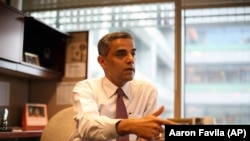One Monday morning in Manila, cars moved in a slow line along the main avenue. Taxi driver Ranilo Banez shook his head at the long line of cars.
Crowded roads have become more common as Manila's economy grows. Mr. Banez said a 10-kilometer (or 6-mile) trip that once took 30 minutes may now take up to two hours.
"We lose so much," Mr Banez, 64, said. "We waste a lot of gasoline and time."
In Manila and other cities in Asia, people are building many office and apartment towers. But the building of roads, railways and other important infrastructure has been slower, in part because of the 1997 financial crisis.
Urgent needs for infrastructure
Before the 1997 financial crisis, many developing Asian countries spent six to eight percent of their yearly economic output on public works. After the crisis, that amount dropped to as little as two percent.
Ramesh Subramaniam is the deputy director general of the Asian Development Bank's (ADB) Southeast Asia department. He says that developing countries have a lot of work ahead of them to build the necessary facilities.
If spending does not increase, "then this could possibly have an impact on future growth," Subramaniam said. "Certainly it is going to reduce the competitiveness of the countries in the region."
Projects in the Philippines
In May, Philippines President Benigno Aquino III approved $1.4 billion in spending for commuter trains in Manila and other projects. That brought the total for infrastructure investment to $31.8 billion since Aquino took office in 2010.
The Philippines is not the only Asian country struggling to deal with crowded roads.
Projects in India
In India, Prime Minister Narendra Modi called for his country to speed up building "all projects that will ensure a modern infrastructure backbone."
India's biggest program is the $100-billion Delhi-Mumbai Industrial Corridor Project. That plan will create seven industrial cities, high-speed railways, six airports and three seaports. The government says India also needs 450 new power plants that use coal.
To keep that up, India needs to spend $1 trillion on infrastructure for the next five years.
Projects in Vietnam and other Southeast Asian countries
In Vietnam, the government approved a proposal in June for a new airport. It will be located near Vietnam's business capital, Ho Chi Minh City, and cost $15.8 billion. The country also plans to spend $22.5 billion on new highways.
The demand for power in Vietnam also increases by 10 percent every year. State media say Vietnam needs to spend $125 billion in the next 20 years to keep up with the demand.
Thailand has a $92 billion building plan for the next few years. The plan includes high-speed train routes that will run from China in the north through Malaysia in the south to Singapore. It calls for expanding seaports and Bangkok's commuter trains.
But, many countries still do not know how they will pay for these projects.
China, Japan and the U.S. to play a role in developing Asia infrastructure
The Asian Development Bank has estimated that developing Asian economies need to invest $8 trillion in the 10 years leading up to 2020. Japan and the United States are the principals behind the Asian Development Bank. Japan has announced a credit plan of $110 billion in aid to pay for Asia's infrastructure projects.
China has said it wants to be a regional leader in investing in infrastructure projects. More than 20 other countries joined with China to open the new Asia Infrastructure Investment Bank, or AIIB. The bank is expected to start with $100 billion in capital, mostly from China.
The Asian Development Bank said building the needed facilities will help people in the region earn more money. If the needed facilities are built, people there could get an extra $4.5 trillion in income in the decade through 2020 and another $8.5 trillion after that.
But many of the planned projects do not have a business plan that promises to produce profits and repay investors. And investors worry about the government interfering or possible delays over environmental and other concerns.
Still, Mr. Subramaniam of the Asian Development Bank said the region's total spending is likely to be less than half the amount required. He says Asia still needs more resources and different ways to pay for the projects.
I'm Jill Robbins.
Dr. Jill Robbins adapted this story with information from the Associated Press for Learning English. Hai Do was the editor.
______________________________________________________________
Words in This Story
infrastructure - n. the basic equipment and structures (such as roads and bridges) that are needed for a country, region, or organization to function properly
facility - n. something (such as a building or large piece of equipment) that is built for a specific purpose
route -n. a way to get from one place to another place
priority - n. something that is more important than other things and that needs to be done or dealt with first
Now it's your turn. What infrastructure projects are needed where you live? Write to us in the comments section.









